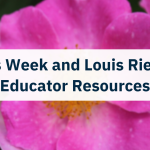Ribbon Skirt Day: Honouring Culture, Strength, and Unity
Ribbon skirts carry deep meaning, with culture, identity, and resilience woven into every fabric thread.
Each year on January 4, people across Canada honour Ribbon Skirt Day, a time to recognize and celebrate the cultural and spiritual significance of the ribbon skirt. For educators, it presents a wonderful opportunity to explore Indigenous teachings and incorporate meaningful cultural learning into the classroom.
The Story Behind Ribbon Skirt Day
Ribbon Skirt Day began with a powerful act of resilience and pride. In 2020, 10-year-old Isabella Kulak, a member of Cote First Nation in Saskatchewan, wore her ribbon skirt to a formal school event. A staff member told her that her skirt was “too casual” and suggested she should have worn a store-bought outfit instead.
The incident sparked a wave of solidarity. Indigenous women and girls across Canada and beyond shared photos of themselves wearing ribbon skirts to show their pride, strength, and cultural identity. Community members also organized a walk in support of Isabella when she returned to school, reinforcing messages of belonging and respect.
In an interview, Isabella stated:
“It makes me feel really happy inside to know that lots of people are representing their culture, and I just don’t want anybody to feel ashamed for who they are. Getting all that support just makes me feel like I can do anything.”
Her story inspired Manitoba Senator Mary Jane McCallum to introduce a bill that led to the creation of National Ribbon Skirt Day, which received Royal Assent on December 15, 2022. The first national observance took place on January 4, 2023.
Traditional Meaning of Ribbon Skirts and Shirts
Ribbon skirts are handmade cloth garments adorned with colourful ribbons, each carrying deep cultural meaning. According to Dorothy Friday of the Caribou (Adik) Clan, a Knowledge Keeper at the Seven Generations Education Institute, ribbon skirts are deeply tied to womanhood and the sacred cycles of life. Friday explains that the skirt’s long, flowing shape connects the wearer to Mother Earth, symbolizing balance, respect, and the nurturing roles women hold within their families and communities.
The ribbons themselves carry personal and spiritual significance, representing the teachings, gifts, and responsibilities that women hold throughout their lives. The skirt’s design allows it to move gently with the wearer, brushing the ground as a reminder of our connection to the land and to all living things. Many teachings describe the ribbon skirt as a form of protection and strength—an outward expression of identity, pride, and resilience that honours ancestry and cultural continuity.
In many communities, ribbon shirts hold a similar meaning. Traditionally worn by men and boys, they symbolize respect, identity, and cultural strength. Each ribbon tells a story—of family, community, or personal values—and creating or wearing a ribbon shirt continues the act of honouring tradition and cultural pride.
Evolving Meanings: Identity and Inclusion
Today, ribbon garments also reflect the diversity and strength of Indigenous identities. Two-Spirit, queer, and gender-diverse Indigenous people are wearing ribbon skirts and shirts in ways that express who they are and how they connect to culture. These garments have become symbols of both cultural pride and personal identity—ways of honouring tradition while embracing individuality.
Tekaronhiokewe Talon Jacobs, a Two-Spirit teen from Akwesasne, shared how creating and wearing a ribbon skirt helped them celebrate their culture and gender identity, saying it made them feel proud and seen. Their story reminds us that ribbon garments are not confined by gender—they are expressions of connection, courage, and belonging.
Two-Spirit designer Geronimo Louie also uses ribbon work to express identity and belonging. In an interview with Vogue, Louie shared how creating and wearing traditional ribbon garments became an act of self-love and visibility:
“[In my community], there’s no Two-Spirit men wearing ribbon skirts. When I first started wearing traditional womenswear outfits, I felt so alone because I didn’t see anybody doing that.”
Whether learners connect more with a ribbon skirt, ribbon shirt, or with another expression of culture, each garment carries the same spirit of pride, resilience, and cultural continuity. As educators, it’s important to share that these garments are about identity, not gender.
Educators can help learners explore these evolving meanings by sharing the stories of Two-Spirit and queer Indigenous designers and Knowledge Keepers who are reshaping traditional regalia to reflect inclusivity and self-determination. Inviting an Elder or Knowledge Keeper to share teachings about the history, Protocols, and meanings of ribbon garments can deepen understanding and foster respectful classroom conversations about how cultural expression continues to grow while honouring long-held traditions.
Ways to Honour Ribbon Skirt Day in the Classroom
Although Ribbon Skirt Day may occur before school resumes in January, consider using these strategies before winter break or as a way to start the new year with creativity and connection.
Here are a few ways you can meaningfully recognize Ribbon Skirt Day with your students:
Start With Research
Have learners explore the origins of Ribbon Skirt Day and the teachings behind the ribbon skirt. This helps build understanding of the day’s importance and shows learners its connection to resilience and cultural pride.
Share Stories
Introduce Isabella Kulak’s story and read age-appropriate books that celebrate ribbon skirts and their teachings:
- Raven’s Ribbons by Tasha Spillett-Sumner (Grades 1–3)
- Stitches of Tradition (Gashkigwaaso Tradition) by Marcie Rendon (Grades 1–3)
- The Ribbon Skirt: A Graphic Novel by Cameron Mukwa (Grades 3–7)
Create and Design
Invite learners to design their own ribbon skirts or shirts on paper. Encourage creativity and reflection. Have them identify which colours and symbols represent their identities and values. Provide younger learners with a simple template to decorate.
Create a Respectful and Inclusive Space
Create a welcoming and respectful space for conversations about Ribbon Skirt Day by encouraging meaningful dialogue, active listening, and appreciation of its cultural and spiritual significance. Acknowledge that ribbon skirts symbolize identity, tradition, strength, and a sacred connection to Mother Earth.
Connect With Community
If possible, host a ribbon skirt-making workshop with a local artist, seamstress, or Knowledge Keeper. They can demonstrate the process, share teachings, and discuss the cultural significance of each step. If an in-person visit isn’t possible, consider watching Serene Weasel Traveller’s ribbon skirt tutorial as a class.
Express Gratitude
Encourage learners to make thank-you cards or letters for guests who share their time and teachings. This helps learners practice reciprocity and respect.
Reflect and Discuss
Invite learners to reflect on what they’ve learned through writing, art, or group discussion. Ask questions like:
- What does the ribbon skirt symbolize?
- How does wearing it express pride and resilience?
- How can we show respect for Indigenous identities and traditions in our school community?
Link to Reconciliation
Connect Ribbon Skirt Day to ongoing learning about reconciliation. Discuss topics such as cultural safety, identity, and respect for Indigenous rights and traditions. Link these lessons to broader subjects, like social studies, history, and citizenship.
Honouring Culture, Strength, and Unity
When we bring Ribbon Skirt Day into our classrooms, we help learners see strength in diversity and the beauty of cultural expression. We model respect, inclusion, and reconciliation—values that strengthen our communities and inspire pride in every learner.
By honouring Ribbon Skirt Day, we celebrate identity and unity while supporting the next generation to walk proudly in who they are and respect the uniqueness of others.
Photo of Knowledge Keeper from Webequie First Nation showing youth how to pin ribbons to a skirt in preparation for sewing. Used with permission from the education team at Simon Jacob Memorial Education Centre.






